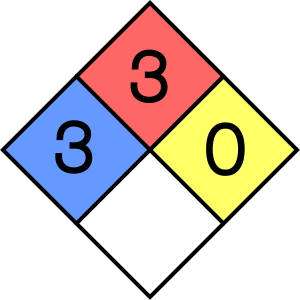CHLOROBENZENE
Basic information
- Chemical formula(s): \({\rm C_6H_5Cl}\)
- Other names: benzene chloride, chlorobenzol, phenyl chloride
- CAS: 108-90-7
- International Chemical Safety Card (ICSC): 0642
- Flammability: yes - highly flammable
- NOAA’s description: colourless to clear, yellowish liquid with a sweet almond-like odour, practically insoluble in water and somewhat denser than water; vapours heavier than air
NFPA 704 (fire diamond)

- Health (blue): 3 - short exposure could cause serious temporary or moderate residual injury.
- Flammability (red): 3 - it can be ignited under almost all ambient temperature conditions. Its flash point is 29 °C. It’s autoignition temperature is 592 °C.
- Instability–reactivity (yellow): 0 - normally stable, even under fire exposure conditions, and is not reactive with water.
- Special notice (white): -
Hazard statements
| Code | Phrase |
|---|---|
| H226 | flammable liquid and vapour |
| H302 | harmful if swallowed |
| H305 | may be harmful if swallowed and enters airways |
| H315 | causes skin irritation |
| H332 | harmful if inhaled |
| H411 | toxic to aquatic life with long lasting effects |
Precautionary statements
| Code | Phrase |
|---|---|
| P210 | keep away from heat, hot surfaces, sparks, open flames and other ignition sources, no smoking |
| P233 | keep container tightly closed |
| P240 | ground and bond container and receiving equipment |
| P241 | use explosion-proof electrical/ventilating/light/…/equipment |
| P242 | use only non-sparking tools |
| P243 | take precautionary measures to prevent static discharges |
| P261 | avoid breathing dust/fume/gas/mist/vapours/spray |
| P264 | wash … thoroughly after handling |
| P271 | use only outdoors or in a well-ventilated area |
| P273 | avoid release to the environment |
| P280 | wear protective gloves/protective clothing/eye protection/face protection |
| P302+P352 | IF ON SKIN: wash with soap and water |
| P303+P361+P353 | IF ON SKIN (or hair): remove/take off immediately all contaminated clothing, rinse skin with water or shower |
| P304+P312 | IF INHALED: call the ETH Emergency Desk: +41 44 342 11 88 (from mobile) or 888 (from landline) if you feel unwell |
| P304+P340 | IF INHALED: remove victim to fresh air and keep at rest in a position comfortable for breathing |
| P312 | call the ETH Emergency Desk: +41 44 342 11 88 (from mobile) or 888 (from landline) if you feel unwell |
| P321 | specific treatment (see the label) |
| P332+P313 | IF SKIN IRRITATION OCCURS: get medical advice/attention |
| P362 | take off contaminated clothing |
| P370+P378 | IN CASE OF FIRE: use dry sand, dry chemical or alcohol-resistant foam to extinguish |
| P391 | collect spillage |
| P403+P235 | store in a well ventilated place, keep cool |
| P501 | dispose of contents/container to HCI-Shop |
Protective measures
Gloves
Occupational Safety and Health Act of 1970 and OSHA Glove Selection Chart categorize gloves into four protection levels (very good, good, fair, poor (not recommended)) for given chemical. The levels of protection against chlorobenzene for four types of gloves are:
- Neoprene: fair.
- Natural latex or rubber: poor (not recommended).
- Buthyl: fair.
- Nitrile: poor (not recommended).
Safety goggles
- Always wear safety goggles when handling chlorobenzene. Corrective glasses are not considered safety googles.
- Handle chlorobenzene inside the fume hood only (with exception of moving the closed bottle to and from the storage cabinet).
Clothing
- Wear long trousers and fully covered shoes.
- Contact lenses are forbidden while working with chemical substances, even in combination with safety glasses.
- Do not wear cosmetics.
- Do not wear synthetic clothing while working with flammable liquids or gases or when a hazard is present as these materials tend to melt and stick to exposed skin.
- Do not wear headphones.
Spill management
- Use personal protective equipment.
- Avoid dust formation, avoid breathing dust.
- Avoid breathing vapors or mist.
- Ensure adequate ventilation.
- Evacuate personnel to safe areas.
- Sweep up without creating dust and arrange disposal.
- Do not let it enter drain.
- If a spill happened outside the fume hood (on the floor or desktop) contact Dr Jakub Tkaczuk (+41 44 632 31 62) and the ETH Emergency Desk (+41 44 342 11 88 from mobile or 888 from landline).